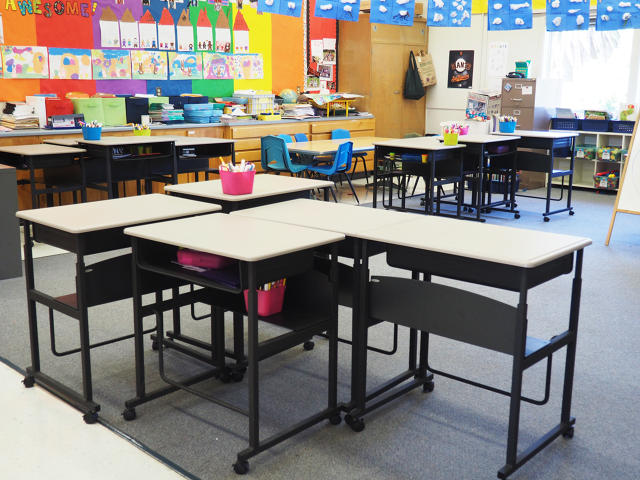Standing in school becoming more popular for engagement, attention
January 18, 2016
Getting students to sit still for long periods of time has been a continuous struggle for teachers. However, schools are now literally taking a stand against the problem. In certain schools, one can now find standing students during classes. This is due to the decision of using “standing desks,” which are higher than the normal desk, some even equipped with “fidget bars.” These bars are attached to the desk and low to the ground, enabling kids to place their foot on the bar and use it as a miniature swing.
This stand up desk movement began in many workspaces and got positive feedback from many workers. Most agree that the desk causes a more active mindset leading to less boredom and tiredness throughout the day, which in the end equals more efficient work.
Already teachers and parents are seeing these same improvements in children who use stand up desks.
“I can hold their attention for longer because I feel like their brains and their bodies are more active and more awake,” said Vallecito Elementary School’s fourth grade teacher Amanda Grey, in an interview with NBC News.
Many other teachers, principals, parents, and even students agree with Grey, all coming back to the alertness being seen as the biggest difference.
Even Nazareth’s language teacher, Mr. Mullen, would like to have one himself, as long as there were storage drawers. As for student use, Mr. Mullen says, “I think that they’re great for all the reasons mentioned.”
With regard to the use of these desks at Nazareth, “it probably wouldn’t be a good idea to go to all stand-up desks all at once. Maybe a couple of rooms in each department to start with just to see how students and teachers like them and then if there’s a positive response Naz could phase them in over time.”
The thought of using stand up desk in schools first occurred when several studies documented children’s health issues linked to sitting too much. These issues included health problems such as diabetes, high blood pressure, cardiovascular disease, and obesity. Action needed to be taken, and that is just what Vallecito Elementary School did.
Vallecito School’s principal, Tracy Smith, has been a long time supporter of stand up desk, even using one herself as she states, “I would never go back.” Teachers at Vallecito have also seen a difference with their more energetic kids who have the need to get up and walk around the class at unnecessary and random times. Instead of doing this, they are now much calmer and won’t have to get up to “sharpen their pencil” ten times in one class period.
Being the pilot school, the faculty is also aware of the tiredness that standing all day causes, and the need to sit throughout the day. This is why students are encouraged to pull over a stool or even to sit on the floor if they feel like it.
Nazareth students have their own varying opinions too. Freshman, Grace Brady, says, “I just don’t think that it’s practical to use for the entire school day. However, I do think that there will be benefits if you know how to balance it [the amount of time sitting versus standing] correctly.”
Sophomore, Jamie Glas, on the other hand, says, “Kids are exhausted, and exerting themselves by standing the whole day, every day, is too much to ask of already overwhelmed students.”
Another problem that many other schools have and will run into, are the price of these new desks. Traditional sitting desks cost approximately $75 per desk, these new standing desks, however, cost $225 per desk. This means that turning an entire elementary school into a stand/sit environment would cost up to $150,000.
Regardless of the pricey desks, students are crediting their new and improved concentration levels to the stand up desk, even though there hasn’t been any official scientific study that this is the case. As a matter of fact, researchers have not yet been able to confirm that these desks improve performance, concentration, or health conditions at all. Nevertheless, students are enjoying these new desks and many see this as the future of education creating a more active, alert, and productive learning environment.

